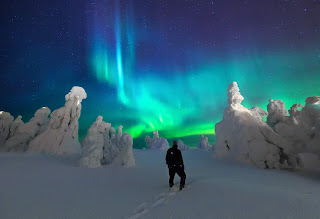The Northern Lights
The Northern Lights, also known as the Aurora Borealis, are a breathtaking natural phenomenon that illuminates the night sky in the Northern Hemisphere. This spectacular display of colored light is caused by the interaction between the Earth's magnetic field, atmosphere, and charged particles from the sun.
The Science Behind the Northern Lights:
The sun emits a stream of charged particles known as the solar wind, which includes electrons and protons. When these particles collide with the Earth's magnetic field, they are directed towards the poles, where they interact with the atmosphere. The Earth's magnetic field acts as a shield, deflecting the charged particles towards the poles, where they collide with atoms and molecules of gases such as oxygen, nitrogen, and helium.
These collisions excite the atoms and molecules, causing them to emit light at specific wavelengths, which we see as the Northern Lights. The color of the Northern Lights depends on the energy of the particles and the altitude at which they collide with the atmosphere. Green is the most common color, produced by collisions at altitudes of around 100-200 km. Red is produced by collisions at higher altitudes, while blue and violet are produced by collisions at lower altitudes.
Types of Northern Lights:
There are several types of Northern Lights, including:
1. Diffuse Aurora: A faint, uniform glow in the sky.
2. Pulsating Aurora: A rhythmic, pulsing light display.
3. Corona Aurora: A circular, crown-shaped display around the zenith.
4. Band Aurora: A horizontal or vertical band of light across the sky.
5. Pillar Aurora: A column of light extending from the horizon to the zenith.
Best Places to See the Northern Lights:
The Northern Lights can be seen in the Northern Hemisphere, primarily at high latitudes. Some of the best places to see the Northern Lights include:
1. Tromsø, Norway
2. Lapland, Finland
3. Yellowknife, Canada
4. Svalbard, Norway
5. Reykjavik, Iceland
Best Time to See the Northern Lights:
The Northern Lights are typically visible on clear, dark nights from late August to early April. The best time to see them is during the peak season, from December to March, when the nights are longest and darkest.
Conclusion:
The Northern Lights are a breathtaking natural phenomenon that inspires wonder and awe in those who witness them. Understanding the science behind this spectacle only adds to its beauty and magic. If you have the opportunity to see the Northern Lights, it is an experience you will never forget.








Comments
Post a Comment
if you have doubt please let me know